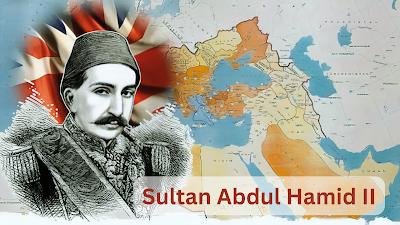 |
| Sultan Abdul Hamid II |
Sultan Abdul Hamid II was born on September 21, 1842, he ascended the Ottoman throne in 1876 and became the 34th Sultan of the Ottoman Empire. His reign, which lasted until 1909, was marked by a complex interplay of political, social, and technological advances that had far-reaching consequences for both the Ottoman Empire and the wider global milieu.
The early years of Abdul Hamid II
saw enormous changes within the Ottoman Empire. He took over a empire that was
facing tremendous problems such as territorial loss, economic insecurity and
political turmoil. As sultan, Abdul Hamid II was faced with the daunting task
of modernizing the region while maintaining Islamic cultural identity and traditions.
One of the distinguishing features
of Abdul Hamid II was his cautious attitude towards modernisation. He was apprehensive
of Western influence and firmly believed in the autonomy of the empire. As a
result, he followed a pan-Islamic approach, and sought to unite Muslims
everywhere under Ottoman control. This strategy was most prominent in his
support for the construction of the Hejaz Railway, which sought to increase the
Ottoman Empire's influence in the Islamic world as well as accelerate the
pilgrimage to Mecca.
However, there was also a dark side
to the reign of Abdul Hamid II. He is often blamed for his dictatorial rule and
suppression of political opposition. Fearing dissent, he dismissed the Ottoman
Parliament in 1878 and ruled by decree for most of his reign. This dictatorial
posture contributed to an unstable situation, along with a growing sense of
discontent among the empire's various ethnic and religious groups.
The Armenian question, one of the
bloodiest chapters of Abdul Hamid II's reign, is still a major historical
controversy. During his rule, Armenians were subjected to mass executions and
forced relocations in the late nineteenth and early twentieth centuries, known
as the Armenian Genocide. Although the extent of Abdul Hamid II's personal
involvement has been debated, these actions tarnished his reputation.
Abdul Hamid II's reign also
coincided with amazing technological advances that were reshaping communities
around the world. The development of telegraph lines, steamships, and railroads
linked remote areas, facilitating communication and commerce. In this setting,
Abdul Hamid II saw the value of modern infrastructure and worked to improve the
technical prowess of the Ottoman Empire. His efforts were illustrated by the
establishment of the aforementioned Hejaz Railway and the first Ottoman
telegraph network.
The Young Turk Revolution of 1908
brought an end to the rule of Abdul Hamid II. The military and civilian leaders
of the movement aimed to create a constitutional government and limit the
sultan's dictatorial powers. Due to internal pressure and the possibility of a
coup d'état, Abdul Hamid II was forced to re-establish the Ottoman Parliament
and adopt constitutional changes.
In 1909, a counter-coup by
conservative elements attempted to restore absolute control to Abdul Hamid II.
However, this effort was short-lived, and he was deposed in favor of his
younger brother, Mehmed V. Abdul Hamid II lived for the rest of his years. He
lived in exile in Italy, where he died in 1918.
The legacy of Sultan Abdul Hamid II
is complex, reflecting the multifaceted issues he faced at a critical moment in
Ottoman and global history. His attempts to strike a balance between
modernization and the preservation of traditional values, as well as his
difficulties with political opposition and unrest, are still the subject of
historical scrutiny and controversy. While he is recognized for his efforts at
modernization and pan-Islamist initiatives, the tragedy of the Armenian
Genocide and his dictatorial inclinations doomed his reign. As scientists and
historians delve into the complexities of his reign, Abdul Hamid II remains a
key figure whose influence on the Ottoman Empire and its fortunes is still felt
and researched today.
For more content, please follow our
blog: @ The Inside History





0 Comments
Please do not enter any spam link in the comment box.